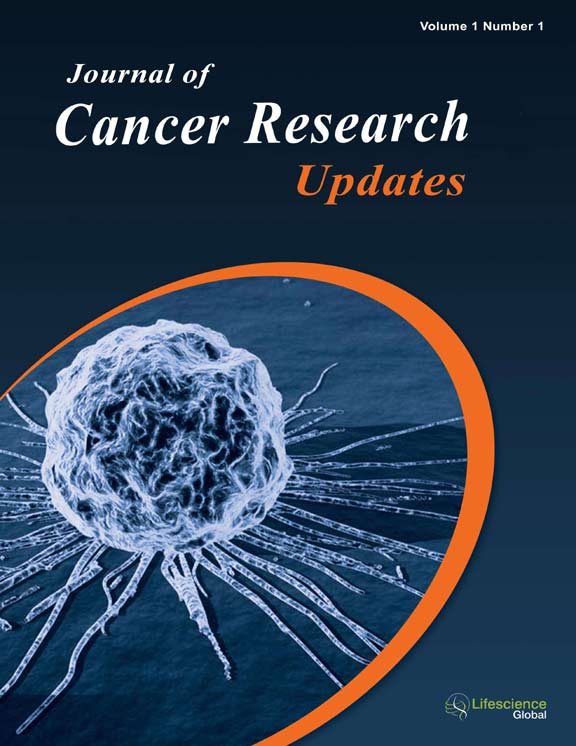jcru
|
|
Abstract: One of the major obstacles to successful cancer chemotherapy is the development of multidrug resistance (MDR) that is associated with the overexpression of ATP-binding cassette (ABC) drug transporter ABCB1 (P-glycoprotein/ MDR1). Currently, the most efficient way to overcome ABCB1-mediated MDR in cancer is by direct inhibition of ABCB1 function. Many drugs with known biological activities have been discovered to inhibit the function of ABCB1 and reverse ABCB1-mediated MDR in cancers. However, clinical trial results suggested that many of these clinically active drugs should not be used as ABCB1 modulators due to direct toxicity or undesirable side effects. In this study, we demonstrated that isoreserpine, an indole alkaloid with relatively low toxicity, can significantly inhibit ABCB1-mediated efflux of calcein-AM, a known substrate of ABCB1, in a dose-dependent manner. Moreover, we showed that at non-toxic concentrations, isoreserpine potently reversed ABCB1-mediated resistance to doxorubicin and colchicine in ABCB1-overexpressing human KB-V-1 epidermal cancer cells. Collectively, our findings revealed that by inhibiting the transport function of ABCB1, isoreserpine can restore drug sensitivity of ABCB1-overexpressing cells to conventional chemotherapeutic drugs. In conclusion, isoreserpine should be further developed into a promising reversal agent for the treatment of MDR in ABCB1-overexpressing cancers. Keywords: Multidrug resistance, Isoreserpine, ABCB1. Download Full Article |
|
|
Abstract: Background:The frequency of digestive cancers is increasing since the last ten years. The aim of the study was to determine the epidemiologic and histologic aspects of digestive cancers in Togo. Method: We conducted a descriptive cross-sectional study focused on digestive cancers cases diagnosed from 1995 throughout 2014 (20 years) at the pathology laboratory of the Lomé teaching hospital. We included all digestive samples (biopsy, excision, surgical specimens) collected and sent to the pathology laboratory from 1994 to 2013 using data from the records of the laboratory. Results: We have collected 1306 cases of digestive cancers (20.4%). The annual incidence was 65.3 cases. The sex-ratio (M/F) was 1.5. The mean age was47.8 years. The most common locations were the stomach (35.3%) and the esophagus (27.3%). The adenocarcinoma was predominant in the stomach (84.4%), the rectum (70.2%), and the colon (86.3%). The squamous cell carcinoma was commonly found at the esophagus (94.8%). The lymphomas were observed in the small intestine (53.4%). Conclusion: Digestive cancers are frequent in Togo and occur in young adults. The stomach cancer is the most common cancer Keywords: Digestive cancers, epidemiology, histology, Togo. Download Full Article |
|
|
Abstract: Background: Gestational trophoblastic tumors originate from trophoblastic tissues and secrete human chorionic gonadotrophin (hCG). Surgical treatment may be a line of treatment of chemoresistant cases. Objective: To evaluate the accuracy of hCG dipsticks in detection of hCG in tissues of trophoblastic tumors and healthy myometrium during surgery of trophoblastic tumors. Methods: We included 19 samples of tumor and apparently healthy myometrial tissues during surgical treatment of 5 cases of gestational trophoblastic tumors. The hCG dipstick was immersed in a solution containing 1x1 cm of tumor or myometrial tissues. The results of the tests were compared to the histopathological results. Results: The mean age of patients were 38.8 years, the mean parity was 3.4. The mean serum B-hCG level was 101,745.6 mu/ml. Except for one specimen in case 5, all results of the hCG dipsticks were concordant with final histopathologic analysis of the specimens. Sensitivity of hCG test was 100% and specificity was 90%. Conclusion: Intraoperative detection of hCG in different tissues and suspicious masses can be considered as simple, rapid, inexpensive, and reliable test. It can be used to detect the trophoblastic nature of tissues if frozen section is not available as some low resource setting countries. We recommend further larger prospective studies to compare the accuracy and reliability of this novel technique and frozen section analysis. Keywords: Trophoblatic tumors, surgery, hCG test. Download Full Article |
|
|
Abstract: The anthocyanins, coumarins, and casearins are interesting compounds due to their chemical and biological properties. In the present study, the in vitro effect of 4´-O-methyl-gallocatechin (an anthocyanin), columbianatin (a coumarin), and casearin G on the mitogenic response and phagocytic activity from whole blood cells, was evaluated. In addition, the cytotoxic effect of these compounds on the cell lines B16/BL6 (murine melanoma) and COS-7 (kidney fibroblasts transfected with SV40 virus) was measured by a colorimetric assay (MTS/PMS, IC50: inhibitory concentration) and the sulphorhodamine B assay (GI50: growth inhibition, TGI: total growth inhibition, LC50: lethal concentration). The results show that 4´-O-methyl-gallocatechin and columbianatin reduced lymphoproliferation. Columbianatin reduced both the phagocytic index and the percentage of phagocytic monocytes/macrophages. Casearin G showed both cytotoxic (IC50, LC50) and cytostatic (GI50) effects against the tumor cells, B16/BL6 (IC50 = 30.8 μM; GI50 = 12.4 μM; LC50 = 34.7 μM) and COS-7 (IC50 = 137.3 μM; GI50 = 3.8 μM; LC50 = 29.9 μM). In conclusion, 4´-O-methyl-gallocatechin and columbianatin showed immunosuppressive properties in vitro while casearin G was the most cytotoxic. Keywords: 4´-O-methyl-gallocatechin, columbianatin, casearin G, peripheral blood mononuclear cells, B16/BL6 melanoma, COS-7. Download Full Article |
|
|
Abstract: Emerging knowledge supports the notion that metabolic reprogramming facilitates the progression of many cancers and in some it could be initiated by mutations in genes related to mitochondrial function. While dysfunctional mitochondria plays a pivotal role in driving metabolic reprogramming, mitophagy that recycles damaged mitochondria by selective and organized degradation appears to be vital for sustaining carcinogenesis. Although the potential of targeting mitophagy as a therapeutic strategy has still remained elusive, poor prognosis and therapeutic resistance of highly glycolytic tumors suggest that inhibitors of mitophagy could be potential adjuvant in radio- and chemotherapy of tumors. We briefly review the current status of knowledge on the interrelationship between mitophagy and metabolic reprogramming during carcinogenesis and examine mitophagy as a potential target for developing anticancer therapeutics and adjuvant. Keywords: Warburg, PARKIN, Oxidative stress, Metabolic Reprogramming, Calcium. Download Full Article |


